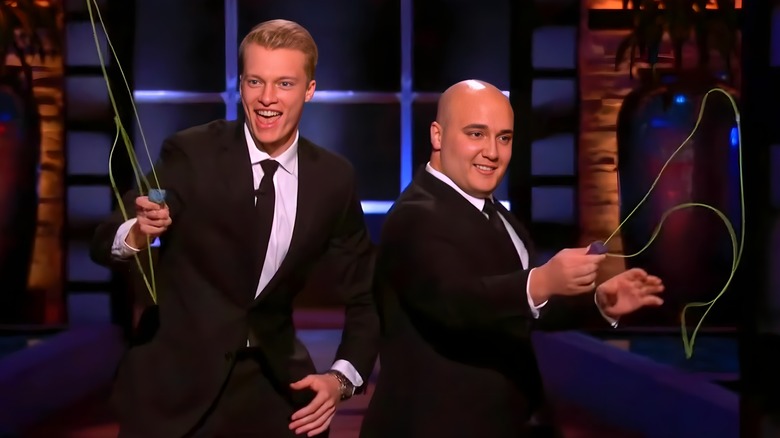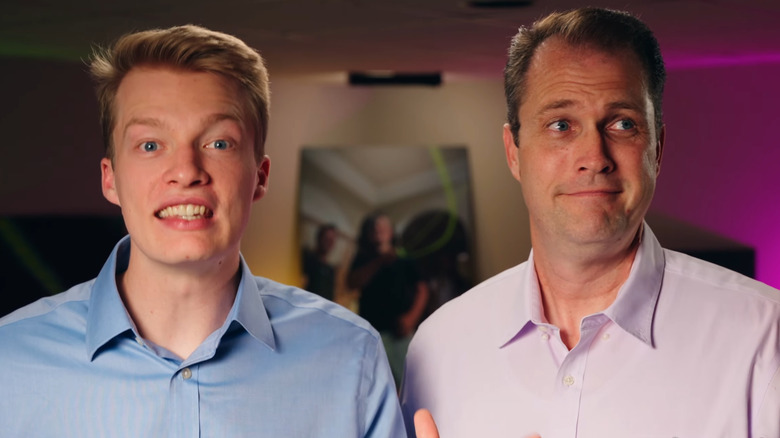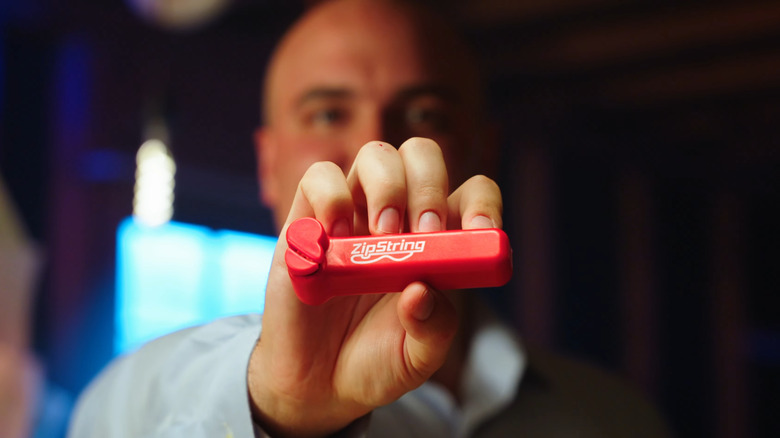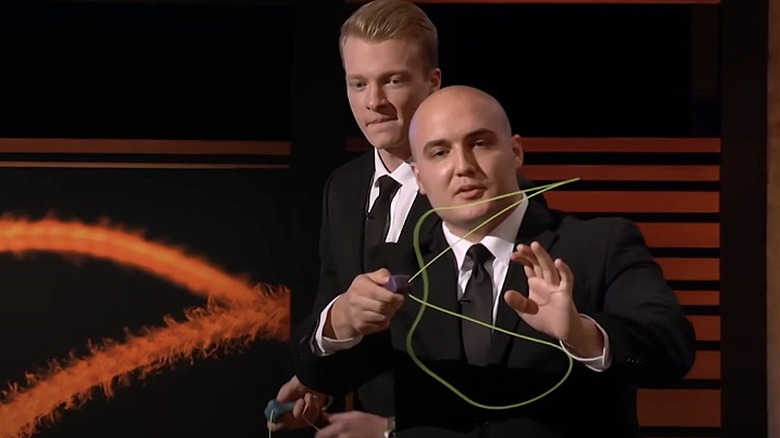Whatever Happened To ZipString After Shark Tank?
We may receive a commission on purchases made from links.
It's not often on "Shark Tank" that entrepreneurs have the sharks out of their seats, laughing and having a blast. But Austin Hillam and Stephen Fazio, who appear in Season 14 of the reality show, do just that. Donning matching black suits and sunglasses, these friends and business partners introduce the sharks to ZipString, a toy that they predict will entertain millions, just as the yo-yo, Etch A Sketch, and Rubik's Cube have done.
It all started when Fazio witnessed a physics teacher demonstrate a tabletop device that launched a string in a loop. Fascinated, Fazio took that concept, compacted it and, with the help of Hillam and Hillam's father, created a handheld plaything. The sharks — especially Robert Herjavec — embrace their inner children as, at the click of a button, they make the strings twirl and swirl about. But did they have enough fun to make them want to invest in the company?
ZipString gets a double deal from Robert Herjavec and Kevin O'Leary
On "Shark Tank," Austin Hillam and Stephen Fazio ask for $100,000 in exchange for 10 percent equity in their business. At first, as they describe ZipString in more detail, most of the sharks seem intrigued. Basically, anything the user does, ZipString follows. The string flies around at 35 mph, is safe to the touch, and is capable of moving in unique designs, including a corkscrew and swirl. There's also a USB-C port to charge the device.
Upon revealing the toy on social media, it garnered 20 million views in a day and reached the front page of Reddit. However, when Hillam and Fazio start to get into the numbers, they lose some shark support. Even after so much social media hype, in addition to being promoted by Dude Perfect, only 10,000 ZipString toys were sold for $25 each. The reason, the entrepreneurs explain, was because they couldn't make them fast enough to meet the demand. One by one, the sharks announce that they're not interested, but Robert Herjavec, a believer in the American dream, is on board. "Couldn't love it more, seriously," the investor says.
There's a back-and-forth between Herjavec, who offers $100,000 for 20 percent, and Kevin O'Leary, who offers $100,000 for 15 percent. After some haggling, Hillam and Fazio secure a joint deal with both sharks for $100,000 in exchange for 20 percent. It's unknown if the deal closed, or whether Herjavec and O'Leary are currently involved with the company.
ZipString continued to produce its original product in Georgia
While some companies, such as SubSafe, create an entire line of products in the months and years after their "Shark Tank" appearance, that's so far not the case for ZipString. Post-show, Austin Hillam and Stephen Fazio continued to only produce the original toy, which is available in five colors: Bodacious Blue, Rock'It Red, Vivacious Violet, Luscious Lime, and Aesthetic Aqua. The price has gone up since "Shark Tank," increasing from $25 to $29.99, though there's an option to save with the purchase of multiple ZipString toys. A pack of extra strings is available for $5.99.
According to the ZipString website, production still takes place where it all started: the Hillam basement in Johns Creek, Georgia. The site says, "Daily, they quickly fulfill orders, pulling from stock that has been neatly stacked against the walls. As ZipString grows it will inevitably outgrow its humble beginnings. But the message that hard work and dreams can still be launched from a basement and yet have influence around the globe, is real."
The website also says that the team is working on the next version of the toy, though no details have been released on what it will look like or do. In the meantime, ZipString is growing its social media presence. It now has over 6,300 followers on Instagram (up from 4,600), over 1,390 on TikTok (up from 870) and 905 on YouTube (up from 650).
Customers have mixed feelings about ZipString
ZipString is still very much in business and bringing smiles to customers and their children. Well, some of them. The toy boasts a 3.9-star rating on Amazon, with many praising the product. One buyer said, "My 6 yo picked this out for his birthday and let me tell you it is endless fun! My 6 yo is not easily distracted or enthralled by much. He could play with this for hours and be content." Another said, "Works as advertised and the loop of string is mesmerizing to watch."
However, not everyone was thrilled with their purchase. While several customers found that the string got tangled too easily, others expressed concern over the toy becoming hot to the touch if used for too long or when charging. One parent detailed how their child played with ZipString only a few times before becoming bored, and suggested it be marketed toward the classroom for science lessons.
At this point, it doesn't seem as though ZipString is going to become the next yo-yo, Etch A Sketch, or Rubik's Cube. Still, there's always a chance that the forthcoming version of the ZipString could become a cultural phenomenon.
Zip String has improved its line-up of products
Since appearing on "Shark Tank," it looks like ZipString has become successful enough to add a brand-new product to its line-up called the ZipString Luma. The Luma has a string that glows in the dark, adding a new kind of fun to the company's toy, and typically retails for $36.99.
The company has also changed the way consumers can light up their ZipString, and has begun offering new packs of strings to add zip to their toys. The Luma Lightning flashes like a lightning bolt and glows in the dark, while the Luma strings glow in the dark and come in fun colors. Meanwhile, the Chameleon Pack provides strings in two different colors that blend together to make a third shade. Lastly, the Psycho Pack allows for all new colors and effects. But consumers definitely haven't left the regular ZipString behind. The toy is still being sold on Amazon as well as in children's museum shops, science stores, and Hobby Lobby.




